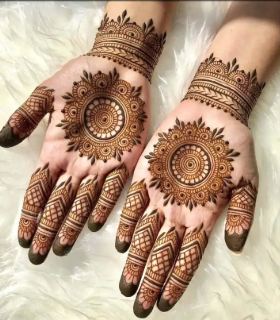Mehndi – A Beautiful Blend of Tradition, Art, and Celebration

Mehndi, also known as henna, is a cherished form of body art that has been celebrated for centuries across South Asia, the Middle East, and North Africa. Made from the powdered leaves of the henna plant (Lawsonia inermis), mehndi is applied as a paste to create stunning designs on the skin, leaving behind a rich, natural stain. Symbolizing beauty, positivity, and tradition, mehndi is an integral part of weddings, festivals, and joyous occasions.
The Cultural Importance of Mehndi
Mehndi holds deep cultural and emotional significance in many traditions. In Indian weddings, applying mehndi is more than just a beauty ritual; it represents happiness, love, and the bond between the bride and groom. It is believed that the darker the mehndi stain, the stronger the love between the couple and the blessings from family. The “Mehndi Ceremony” is a joyous pre-wedding event where friends and family gather to celebrate, sing, and dance while intricate designs are applied to the bride’s hands and feet.
In addition to weddings, mehndi is a staple for festivals like Eid, Diwali, and Karva Chauth, symbolizing celebration and prosperity. Women and girls adorn their hands with delicate patterns to mark these special moments, adding an artistic touch to their festivities.
Types of Mehndi Designs
Mehndi designs have evolved over time, with styles to suit every occasion and taste:
- Indian Mehndi: Intricate and elaborate patterns covering hands and feet with motifs like paisleys, peacocks, and flowers.
- Arabic Mehndi: Minimal yet bold designs featuring flowing vines, leaves, and geometric shapes with ample spacing.
- Pakistani Mehndi: A fusion of Indian and Arabic styles, offering detailed patterns with floral and lace-like elements.
- Moroccan Mehndi: Symmetrical, tribal patterns and geometric designs with a contemporary touch.
- Modern Mehndi: Personalized designs featuring names, initials, mandalas, or trendy tattoos for casual events.
Tips for Long-Lasting Mehndi
- Leave the mehndi paste on for at least 6–8 hours for a deeper stain.
- Apply a sugar and lemon mixture to keep the mehndi moist and intensify its color.
- Avoid water and scrubbing the area for at least 12–24 hours after removing the paste.
Mehndi: A Timeless Tradition
Mehndi is more than just art; it is a reflection of culture, emotion, and celebration. Whether for brides, festive occasions, or casual adornment, mehndi continues to be a timeless tradition that brings people together, creating memories through its beauty and elegance.
Comments
Post a Comment